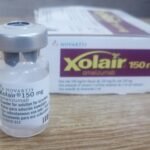Dupixent Vs Xolair is a comparison of the two biologics (monoclonal antibodies) that might be prescribed for diverse illnesses like intense to mild allergies, atopic dermatitis, nasal polyps, chronic sinusitis, allergies, and eosinophilic asthma (Allergic asthma).
These antibodies are produced by way of a single twin of a cellular line having comparable antibodies. Such unique forms of antibodies are very targeted and powerful when treating diseases like asthma and atopic dermatitis.
These “mabs” or monoclonal antibodies are prepared in the laboratory by recombinant DNA technology and purified to the highest degree. Because they are very specific in targeting certain body pathways, they have minimal side effects.
Xolair (Omalizumab) Injection: Uses, Dosing, Side effects, MOA, Price
What are Dupixent and Xolair?
Dupilumab, which comes under the name of Dupixent, is a human monoclonal antibody that blocks the signaling process of interleukin-thirteen and interleukin-four.
It actually binds to the receptor complex of IL-4Rα which is shared by both IL-4 and IL-13. Hence, it blocks the functioning of both IL-4 and IL-13.
By binding to the IL-4 receptor complex, it inhibits the functioning of important cells involved in the pathogenesis of asthma and allergic conditions.
Thus, it ends up reducing the production of IgE antibodies by up to 70 %. IgE antibodies are the major direct mediator that causes airway narrowing in asthma. It is also involved in allergic skin symptoms.
Omalizumab, sold by the brand name of Xolair, has a different mechanism of action than Dupixent.
It restricts the binding of IgE antibodies to the IgE receptors that are typically present on the surface of basophils and mast cells.
IgE-mediated activation of allergic cells (mast cells, basophils, and eosinophils) is inhibited by Xolair. This results in less release of the final mediators of inflammation. Hence, it is used in refractory allergic conditions that are mediated by IgE [Ref].
Dupixent Vs Xolair: Indications of Use?
Monoclonal antibodies like Dupixent (Ddupilumab) and Xolair (Omalizumab) are used to treat mild to severe asthma.
Dupixent is also used to treat patients with moderate to severe atopic dermatitis (Eczema) in patients who are unable to keep a hold on their illness with topical prescription medicines or for whom the treatment plans aren’t suitable.
In the treatment of Eczema, Dupixent can be used in addition to or instead of topical corticosteroids. Dupixent is also used to treat chronic rhinosinusitis with nasal polyposis and has recently got FDA approval for the treatment of eosinophilic esophagitis.
Indications of Use: Dupixent Vs Xolair | |
Dupixent | Xolair |
| Moderate to severe persistent eosinophilic asthma in children 12 years of age or older or in patients with oral corticosteroid-dependent asthma | Moderate to Severe Persistent Asthma in patients 6 years of age or older |
| Chronic rhinosinusitis with nasal polyposis in patients who have not responded to topical corticosteroids | Nasal polyps in adults 18 years of age or older who have an inadequate response to topical corticosteroids |
| Atopic dermatitis in children 6 years of age or older who have not responded to topical corticosteroids | Chronic idiopathic urticaria in children 12 years of age or older who have not responded to antihistamines. |
| Eosinophilic esophagitis in patients 12 years of age or older who weigh at least 40 kgs. | – |
Xolair, on the other hand, has got FDA approval for the treatment of moderate to severe allergic asthma, nasal polyps, and chronic urticaria.
Summary of Indications: What are They Prescribed For
Dupixent:
- Eosinophilic Esophagitis,
- Chronic Rhinosinusitis with Nasal Polyps,
- Atopic Dermatitis or Eczema,
- Moderate to severe persistent eosinophilic asthma.
Xolair:
- Chronic urticaria,
- Moderate to severe allergic asthma
- Nasal Polyps
Which is more effective in severe Allergic Asthma: Dupixent or Xolair:
There haven’t been any direct comparative studies conducted between the two biological medications. One indirect comparison showed similar efficacy and safety outcomes except for an improvement in the lung function test.
At 48 to 52 weeks of treatment, participants in the Dupxent group had an overall better FEV-1 (+96 ml) compared to participants in the Xolair (Omalizumab) group [Ref].
Another study compared the efficacies of Dupixent Vs Xolair in the treatment of CRSwNP (chronic rhinosinusitis with nasal polyps).
The study concluded that both Dupixent and Xolair are effective therapies, however, Dupixent ranked number 1, followed by Omalizumab (Xolair) and Mepolizumab (Nucala).
The efficacies of Omalizumab and Mepolizumab were similar but adverse reactions were more in patients treated with Mepolizumab (Nucala) [Ref].
Dupixent Vs Xolair Drug Interactions:
Dupixent is known to engage with a terrific quantity of different drugs, a complete of 68. Out of those 68 interactions, there are 34 that are acknowledged to be major with 91 generic and brand names, nearly 27 moderate interactions with 90 generic and brand names, and ultimately 7 minor interactions with 33 generic and brand names. Such tablets may consist of, warfarin, live vaccines, and cyclosporine.
On the opposite end, Xolair has very few interactions with other pills, a complete of 9. Out of these nine interactions, only 2 are major with just 4 brand and generic names, and the other 7 interactions are minor ones with 33 brand and generic names.
In case you’re getting allergic reaction shots, consult your physician before taking Xolair. There may be a risk that Xolair will interact with other medicinal drugs.
Inform your doctor about all of your drugs, each prescription and over-the-counter. Vitamins, minerals, natural products, and medicines endorsed by means of different doctors are all counted in.
Do not begin taking a new drug without first consulting your health practitioner. Xolair ought to simplest be used at some stage in pregnancy if it has been prescribed. It’s unknown if this drug goes into breast milk. Before you start nursing, speak to your physician.
What about disorder Interactions
Dupixent has interactions with immunizations, visual defects, and lastly helminths contamination.
Xolair has a single one with malignancies.
How to administer Dupixent Vs Xolair?
Dupixent is administered in a 600 mg starting dose (two 300 mg injections at various injection sites), which is followed by 300 mg every other week.
Xolair is given as just an injectable in dosages ranging from 150 to 375 mg every 2 to four weeks based on the body weight and IgE levels in the blood.
Top-notch differences in side effects of Xolair vs Dupixent:
For Dupixent:
- Pain in the eye, watery eyes, itching, and redness of the eye.
- Blood vessel inflammation happens every so often.
- Skin irritation and insensibility in the higher and lower limbs.
- The most common side effect is injection site reactions, burning, and may swell on occasion.
- Belly aches in conjunction with nausea and vomiting.
- Sore throat, toothaches, and joint pain.
- Insomnia is certainly one of its side effects.
For Xolair:
- The hazard of positive cancers like breast cancers, prostate cancers, and pores and skin cancer may be elevated.
- Whilst you are using Xolair on your medications, you’re quite susceptible to infections as a result of parasites, so you need to keep away from going to places where particular infections are common.
- Hives and rashes are not unusual.
- Lips, throat, and face may swell.
- Fever and muscle pain can occur.
- Problems in hearing may occur as a result of Xolair.
- Symptoms of heart attack and blood clots may occur.
- Nose bleeding is also referred to as epistaxis.
- Joint ache or bone pain.
- Pain in sinuses.
Injection site reactions are typical side effects of Dupixent and Xolair (itching, redness, stinging, ache, bruising, warm temperature, burning, or swelling).
Dupixent and Diabetes: Does Dupilumab Protect You or Expose You?
Red-eye (conjunctivitis), swollen or puffy eyelids, oral herpes, corneal inflammation (keratitis), eye itching, different herpes simplex virus contamination, and dry eye are all side impacts of Dupixent that are different from Xolair.
Headache, tiredness, joint or muscle discomfort, dizziness, ear ache, hair loss, sore throat, cold signs and symptoms, itching or pores and skin rash, and leg or arm pain are a number of Xolair’s side impacts that are different from Dupixent.
Dupixent Vs Xolair: Their Respective Precautions
Xolair has the capability to induce anaphylaxis, a life-threatening hypersensitive reaction that requires emergency clinical intervention.
Anaphylaxis can show up directly once or take up to four days after taking this medicinal drug. In case you or your child develops a rash, cough, chest tightness, trouble respiration, dizziness, drowsiness, fainting, rapid or susceptible heartbeat, tension, flushing, itching, hives, feeling warm, swelling of the throat or tongue, throat tightness, hoarseness, or issue swallowing after taking this medicine, contact your physician right away.
Injecting Dupixent into sensitive, injured, bruised, or scarred pores and skin isn’t advocated.
This medication comes in the shape of a prefilled pen or syringe. Adults and children over 12 ought to use the prefilled pen.
Allow 30 to 45 mins for the drugs to come back to room temperature prior to use.
Dupixent Vs Xolair Price Comparison:
One 75 mcg injection of Xolair costs $ 650 USD and the 150 mcg injection costs $ 1300 USD.
Compared to Xolair, one injection of Dupilumab (Dupixent) costs $ 1692 USD.
Xolair is cheaper than Dupixent.



